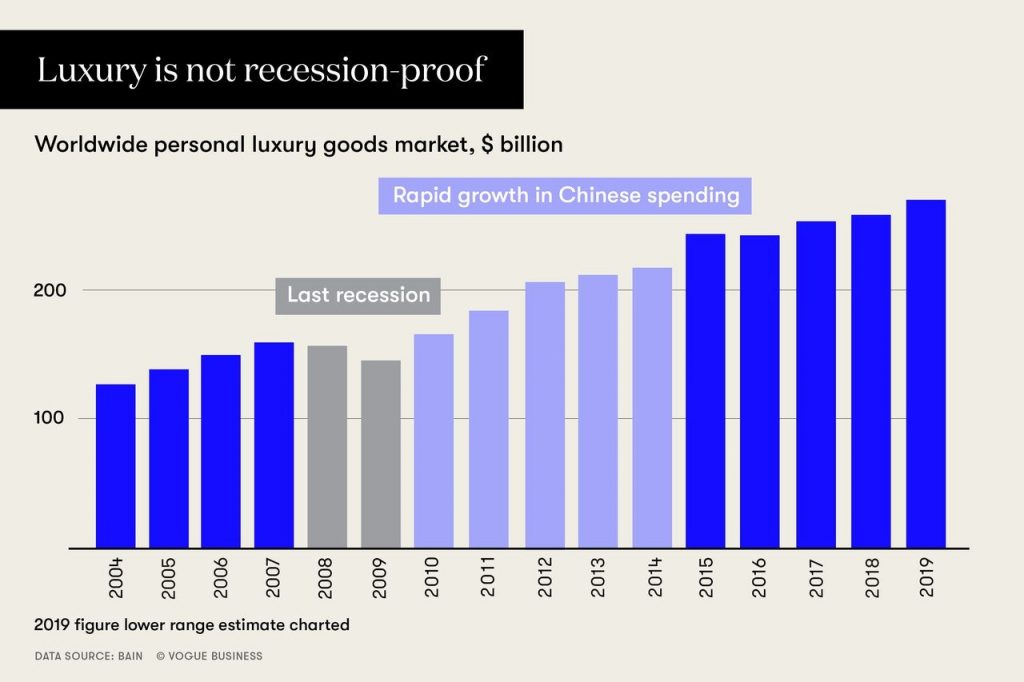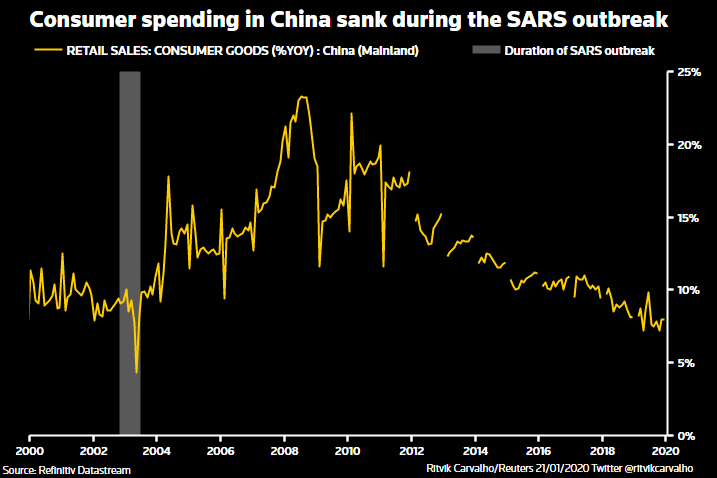Luxury Brands in a Time of Crisis and Recession
Luxury Brands in a Time of Crisis and Recession
A stock market crash occurs when shareholders look to dump their holdings of stock, shifting prices down. An unexpected economic event, catastrophe, or crisis can trigger a panic among the population to cause a crash. Due to the most recent events, the markets are beginning to plummet as the consumers begin to worry about the coronavirus. As majority of the products are made overseas, sectors are beginning to close off in order to contain the virus and prevent it from spreading. What was not realized in the process is how it would initially impact the stock of certain businesses.
Nearly all sectors have felt some sort of impact. So how does this impact the luxury sector? Due to several parts of China on lockdown and travel between the mainland and Hong Kong being restricted, the world’s leading luxury market is hurting. This severity continued to move to other countries such as Japan, Korea, Europe, and now the United States. Italy has taken one of the biggest hits so far, as it is disrupting their supply chains for many brands that source their products in Italy. Consumers have been deferring, reevaluating, or canceling their purchases due to the fear of being exposed to contamination. As uncertainty and new restrictions continue to be implemented, many are avoiding the purchases of non-essentials and focusing on preparing for the crisis. Right now, the only importance of people is hand sanitizers, masks, and toilet paper, causing sales to boom and willingness to purchase these items at any cost (“How Luxury Brands Can Win During a Crisis”) .

The travel industry has taken the biggest hit as well. There has been constant talk about halting all air travel as long as coronavirus continues to spread at an alarming rate. For the United States, this would include all international and domestic flights. Airports are becoming emptier by the minute due to substantial travel restrictions, canceled events, and working remotely from home. The attendance of consumers at shopping malls have also become extinct due to the fear of infection.
However, this isn’t the first crisis that the luxury sector has gone through. Back during the 2008 Financial Crisis, it was proved the the luxury sector is susceptible to a crisis. The “economic downturn of 2008-2009 shaved 9 per cent off the value of the luxury goods market, although it recovered quickly” (“What Happens to Luxury During a Recession”). According to the graph provided below, high-end department stores had the worst outcome with sales pivoting by 25% in 2009, causing overabundance of stock and flash sales to erupt. Yet, Heritage luxury brands had a better outcome than most. Despite these downfalls, the recovery process was quick due to the huge increase in Chinese consumer spending from 2010-2014. Sales may have recovered but the 2008 Crisis impacted on luxury fashion had been long-lasting, causing minimalism to occur within fashion, more democratic styles, and taking discounts for granted (“What Happens to Luxury During a Recession”).

Brands that came out the strongest after the 2008 Crisis took steps to ensure that their companies would not be badly impacted. They put their brand before anything else, focusing on core values and making sure the brand storytelling was on-point. The redefined their brand by introducing new collaborations and offering inspired products that influenced customers more than competitors. Brand also prioritized their customers by providing superior customer service than most through solely bring brand-specific and personalized (“How Luxury Brands Can Win During a Crisis”) .
SARS, a contagious and sometimes fatal respiratory illness caused by a coronavirus, had a major impact on the luxury sector, causing luxury market to deteriorate in 2003. The spread of this caused sales to plummet, especially in key Asian markets. The threat of the SARS virus held the luxury sector hostage in 2003 as global travel, on which the luxury sector depends, took a hit. It was predicted that the “SARS epidemic in Southeast Asia is likely to have a negative impact on luxury goods sales in the region…Southeast Asia ex-Japan is a very important market for the sector because it accounts for about 14 percent of total global industry sales”. (“SARS Brings Luxury Market Down”). The global economic loss due to SARS was estimated to be $40 billion, and a briefing by International Air Transport Association in 2006 estimated that the “world gross domestic product suffered a 0.1% hit due to the outbreak” (“Factbox: How a Virus Impacts the Economy and Markets”). Retail sales figures in China, as showed in the graph below, caused a marked drop-off as consumer spending took a hit from about 10% in the beginning of 2003 to a decreasing spike of below 5%.

Japan took a big turn during the Bubble Burst in the 1990s, where stock market and real estate prices were greatly inflated. Even after this crisis, some people still had money and brand allegiance towards their favorites. Known as “Parasitic Singles”, this particular group was represented by a working class of men and women from 25-34 who still lived with their parents and spent all their money on luxury and travel. Major designer companies like Louis Vuitton, Prada, and Chanel, simply thrived during this time in Japan. Despite the Bubble Burst, Japan thrived during the early 2000s as the luxury area Ginza saw its first “mega flagship stores” from Hermes, followed by Chanel and Louis Vuitton. Contemporary brands followed into the surrounding neighborhood of Aoyama with stand alone stores. In the late 2000s, Japan had accounted for 40% of luxury goods sold worldwide and became the second largest luxury market (“Buying Vintage Brand in Japan: The History of Luxury Brands in Japan”).
There are several steps that businesses within the luxury sector can take in order to maintain their business and make sure that they successfully recover from any type of recession. Rationalizing in cost helped businesses reduce expenses, reign in spending, and reduce expansion. This strategy also includes hiring freezes, reducing number and size of the collections, and rationalizing media spending. Brands can also globalize by seeking the opportunity of expanding geographically and touch new potential customer bases. Diversifying allows brands to expand their horizons into different traditional luxury categories, but some brands hold true to their values and resist a crisis by not changing at all (“Five Strategies Used by Luxury Brands to Survive the Crisis”). It’s also vital to invest in the most valuable customers by offering them loyalty by looking at alternatives like loyalty programs, offering education, training or new experiences.
When staying relevant and innovative is critical, it’s also important to re-valuate and reinvent the brand image. Creating cutting-edge products and remolding relationships with consumers can only be successful when a luxury brand learns to adapt and change to its new interface of marketing and advertising.
Take for instance, the Tom Ford era at Gucci. When Tom Ford landed the role of Creative Director at Gucci in 1994, the brand was going through its hardest phase. With sales on a decline, Gucci hardly had a story to tell as it was mostly known for its leather goods and scarves then. With Ford’s entry, the brand was recognized for its sleek, sensual and rebellious silhouettes. He revolutionized the brand by creating a symbiotic relationship between what the consumers wanted and the brand’s ideology. (“Proof That Tom Ford-Era Gucci Was Fashion At Its Peak”)
Similarly since Alessandro Michele was appointed the Creative Director of Gucci, he brought over many ingenious changes and refueled the retail expansion. Gucci collaborated with many celebrities and artists to star in their latest campaigns that helped show versatility of the brand and appeal to a younger demographic. He brought vintage back my modernizing and making it fashionable. Michele leveraged on social media and created a strong digital presence by connecting with millennial shoppers. His collections time after time incorporated streetwear elements that fit an urban streetwear aesthetic. (“Gucci Reinvention – How Alessandro Michele Revamped the Brand”)
A brand that completely changed the face of street fashion is the Milan-based fashion bran Off-White by Virgil Abloh in 2012. Known to be the “hottest brand in the world” Abloh is recognized for changing culture, diversity and shifting genres within fashion. While some call this a trend that will become passé, there’s no shying away from the cult-culture he formed with Off-White. He has managed to capture a young audience while still painting luxury prices and quality. (“How Has Virgil Abloh Influenced Fashion?”)
Some of the creative marketing strategies by luxury goods were sparked during the time of recession. A pioneering strategy is understanding customer behavior and attributes of buying in a tough economic environment. The knowledge of recognizing shopping psychology patterns have proven to benefit luxury brands in a financial crisis. (“Why Some Luxury Brands Thrived in the U.S. Despite the Recession”)



In times like these, it is imperative for consumers and businesses to be prepared for the worse to come. Take the necessary precautions for when a crisis like this comes around. Planning ahead and purchasing necessities is vital to ensure that a better future is guaranteed. In regard for businesses, it is essential that they focus on connecting with their consumers and focus on prioritizing their brand more than anything. Despite this during epidemic already affecting markets, it is only a matter of time before it gets better. Now is the time to prepare for what is yet to come.





